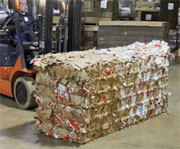Safe and Healthy Environment

Deborah Giannoni-Jackson
Vice President,
Employee Resource
Management
What’s New
- More OSHA VPP sites than all federal agencies combined. Provide assistance to other organizations in the program.
- Reduced vehicle accidents by nearly 2,300 in FY 2009, down more than 10 percent from FY 2008.
We have a longtime commitment to safety and environmental programs.
Working with the Occupational Health and Safety Administration (OSHA) and other federal agencies, USPS has significantly reduced its rate of injuries and illnesses, and successfully addressed ergonomic risk issues. USPS participates in OSHA’s voluntary protection program (VPP) at 275 of our largest facilities.
Environmentally, we are focusing on increasing our recycling efforts, reducing our solid waste and lowering our greenhouse gas (GHG) emissions.
Facts and Figures
40%
more lobbies
of Post Offices have customer recycling
51%
recycling
of solid waste we produce exceeding federal guidelines
1
coffee maker
has same carbon impact as the mail for a typical American family
Safety and health
The Postal Service’s FY 2009 safety performance record showed a positive trend as employees continued to demonstrate safe working habits. End-of-year performance shows that OSHA injuries and illnesses were down 5,400.
That’s a 13.9 percent improvement over FY 2008. This includes handling and lifting accidents, slips, trips and falls, and motor vehicle accidents.
Our employees had 2,259 fewer vehicle accidents in 2009 compared to 2008. The screening, testing and training efforts of our driver safety program created in 2008 showed results in 2009 and contributed to a 10.2 percent reduction in motor vehicle accidents.
Our strong showing in this safety category was a major contributor to the overall safety performance improvement we had throughout this fiscal year.
Ergonomic risk reduction program
We partnered with our unions to educate employees about ergonomic safety — how people interact with their equipment, machinery and work conditions — and to identify the sources of musculoskeletal disorders. These disorders can occur when the muscles and skeleton are injured over time while employees are handling, lifting or moving mail and equipment.
The early identification and redesign of potentially troublesome work procedures allows the Postal Service to control the risk factors that can cause injuries to employees.
The ergonomic risk reduction program expanded in 2009 to include 176 mail processing facilities and nine districts.
These sites trained more than 22,000 employees and implemented 2,492 redesigns to work procedures.
As a result of this effort in 2009, injuries caused by throwing, pushing, pulling, bending or repetitive motion — excluding handling and lifting — were reduced by 1,153, or 21.4 percent.
Life Cycle Inventory of Mail
The Postal Service commissioned a study designed to promote a fact-based discussion of mail’s impact on the environment.
The resulting report, Life Cycle Inventory of Mail, was released in FY 2009. The study provides a baseline that can be used to measure the impact of our ongoing environmental programs and help guide improvements.
The report, an industry first, examines the energy consumption, waste generation and pollutant emissions associated with the production and delivery of mail in the United States.
The study’s results will continue to help us evaluate USPS efficiency and business improvements that will benefit the environment. Then we can pass along these ideas to the mailing industry.

Waste and recycling
Solid waste disposal generates greenhouse gas emissions. According to the U.S. Environmental Protection Agency, for every ton of mixed paper the Postal Service recycles, a metric ton of GHG is avoided.
Last year, USPS generated an estimated 423,988 metric tons of municipal solid waste. We recycled over half that waste — approximately 214,682 metric tons. This exceeds The White House recycling goal of 50 percent.
Zero waste
In 2009, the Postal Service expanded its “zero waste to landfill” program from one pilot site to 19 facilities.
Nine vehicle maintenance facilities and nine processing and distribution centers successfully increased their average recycling rates to 92 percent for the maintenance facilities and 87 percent for the processing centers.

From the cover
USPS is encouraging customers to “read, respond and recycle.” In 8,000 Post Offices nationwide, signs remind PO Box customers to open their mail, take whatever action is necessary and place the waste in recycling bins.
Greenhouse gas emissions inventory
In 2008, the Postal Service’s total carbon footprint emission for Scope 1 and Scope 2 was 5.2 million metric tons of carbon dioxide equivalent (CO2e).
Overall, the total reported emissions for CY 2008 were 1.5 percent lower than the CY 2007 reported emissions. However, the CY 2008 greenhouse gas (GHG) inventory included additional categories which were not reported in CY 2007. A year-to-year comparison of categories reported in both years reflected a 2.6 percent decrease in emissions.
The Postal Service was the first federal agency to complete and publicly report a greenhouse gas inventory for its entire U.S. operations. The Postal Service elected to quantify, independently verify and publicly report its GHG inventory to voluntarily demonstrate its environmental leadership among federal agencies.
In addition, the GHG emissions inventory enables USPS to identify improvements to the existing data collection systems needed to produce high-quality, verifiable data. Verifiable data helps us make informed decisions on GHG reduction strategies. It also allows senior managers to identify areas where significant carbon reductions can be achieved.
The Postal Service also has estimated, but did not verify or report, some categories of Scope 3 emissions to obtain a more comprehensive understanding of the impact of GHG from operations.
All 2008 Scope 1 and Scope 2 emissions were reported to The Climate Registry (TCR) — the leading GHG registry in North America. The Postal Service reported these emissions to TCR to establish an accurate, credible and transparent GHG inventory based on protocols recognized by the international GHG community. USPS based its submissions on the requirements of TCR’s general reporting protocol.
Lobby recycling
We are committed to recycling. One way to do that is through our lobby recycling program, which allows customers to recycle mixed paper in Post Office lobbies.
The program was expanded in 2009 to 5,579 locations — an increase of 40 percent over the previous year.

Voluntary protection program
The Postal Service is the industry leader with more OSHA VPP-certified sites than all other federal agencies combined. Participating sites are VPP-certified after successfully completing an in-depth OSHA inspection.
They also mentor other organizations that want to participate in the program. They assist OSHA by serving in leadership positions in local federal safety and health councils.
The Postal Service increased its number of VPP-certified sites from 149 in 2008 to 168 in 2009, almost a 13 percent expansion.
